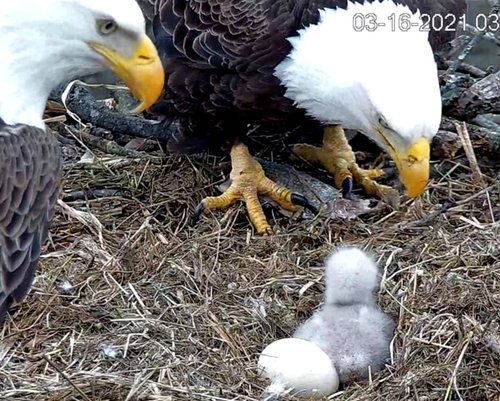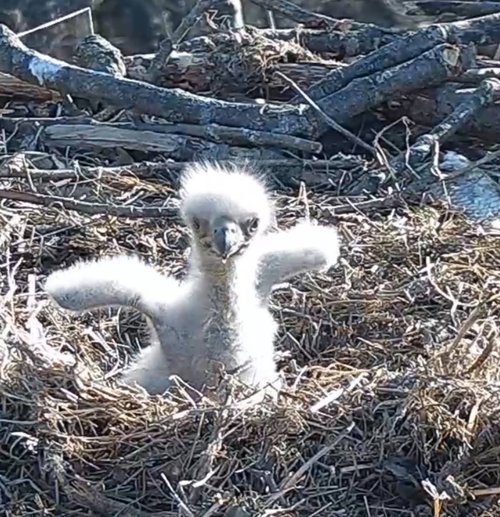Hanover Bald Eagle Blog # 12 - 2021
March 12, 2024
In partnership with Pennsylvania Game Commission and Comcast Business .

Given the hatch date of H313, it’s impossible to tell whether this beautiful bundle of feathers came from the first or the second-laid egg. Either way, the remaining egg is, at this point, officially nonviable. The “hatch window” for bald eagles is between 34 and 38 days, with 35 days being the average. There have been rare accounts of eggs hatching later, however I could not find any mention of eggs hatching this late in the game.
Watching the Hanover hatchling grow up without a sibling is understandably bittersweet. However, it’s important to remember that with fewer mouths to feed, the Hanover parents will have more energy, time, and attention to offer their single kiddo. Almost all North American raptor species hatch asynchronously, meaning the eggs hatch at different times. This gives the first hatchlings advantages over their siblings, and ensures that when food is scarce, at least some hatchlings (or, in the case of eagles, one hatchling) will fledge. According to Ian Newton, world renown raptor biologist and author of the seminal text Population Ecology of Raptors, asynchronous hatching is likely an adaptation that allows all young to survive in “times of plenty,” but ensures that at least one youngster will survive when food availability is unpredictable.
Seen in this light, we can rest assured that while two hatchlings would have been more fun to watch, one hatchling is absolutely better than none. And, in terms of regional bald eagle population dynamics, one Hanover hatchling instead of two will not have a significant impact on the population, which is doing very well.
There are several potential reasons why one of the eggs did not hatch:
- The chick was unable to break out of the shell
- Incomplete fertilization
- Embryonic death
Sometimes a fully developed chick will struggle to emerge from the egg, either because it is too weak, oriented downward at hatch time, or too large to properly maneuver through a small opening. The size of a chick can be impacted by humidity levels; high humidity increases the rate of water loss within the egg resulting in a smaller, weaker individual. We did not see clear signs of emergence such as a crack or a pip in the eggshell, implying that incomplete fertilization or embryonic death are the most likely causes of the egg failure.
Incomplete fertilization may have occurred if the female’s ovum was not fertilized by the male's sperm at the right time, either due to poorly timed copulations, low sperm count, or poor-quality sperm.
Embryonic death could have taken place at any stage in development. A potential reason for this outcome would be insufficient gas and water exchange between the inside and outside of the egg. The composition of the eggshell must be the right thickness to allow gas exchange, yet simultaneously prevent bacteria from entering the inside of the egg. If there was an imbalance in these structural components, growth may have failed. As development progresses, the eggshell naturally becomes thinner as the chick absorbs some of the calcium into its bones, and consequently the egg becomes more delicate and susceptible to breakage. Although the Hanover parents were noticeably careful around the egg, jostling may have occurred without notice and if an opening was created, bacteria may have entered. Other potential causes of embryonic death can be insufficient nutritional health of the mother, issues with rolling the egg, or inadequate incubation resulting in a poor growth rate for the embryo. As we all know, the Hanover parents are experienced incubators and rarely left the egg. Therefore, whatever happened was likely internally derived.
Bald eagle eggs across North America fail to hatch every year. Thankfully though, many nests produce at least one healthy fledgling. The natural ebb and flow of nest productivity is a reality that birds have been facing for time immemorial, and while our hearts ache for the unhatched egg, the Hanover nest will still be filled with story and exciting milestones in the season ahead.
The Hanover hatchling will undergo many changes as he or she slowly matures into a teenager. At this point, one week after hatching, they are developing a second layer of down. Flight feathers will begin emerging at two to three weeks of age. Keep your eyes peeled and enjoy the fluffball stage -- before you know it, that fluffball will be an eagle.

NOTE ON THIS WEEK’S EVENTS:
1) It is normal for parents to temporarily leave their hatchling, especially during shift changes. Even when the youngster is left alone, the parents remain close by, keeping watch and communicating with each other. They’ve got parenting down. Their choices are, more than likely, the right ones.
2) Intruder events, in which another bald eagle attacks or challenges a nesting pair like the Hanover parents, are becoming more common as the population of bald eagles in the east continues to grow. Stay tuned for next week’s blog on intruder events to learn why eagles duel.
SOURCES
Buehler, D. A. (2020). Bald Eagle (Haliaeetus leucocephalus), version 1.0. In Birds of the World (A. F. Poole and F. B. Gill, Editors). Cornell Lab of Ornithology, Ithaca, NY, USA. https://doi.org/10.2173/bow.baleag.01 ;
Desert Sun (2020). Bald eagle eggs laid in Big Bear might not hatch. Retrieved from: https://www.desertsun.com/story/news/environment/2020/02/24/bald-eagle-eggs-laid-big-bear-might-not-hatch/4862507002/
George Miksch Sutton Avian Research Center (2020). Live Bald Eagle Nest Camera. Retrieved from: https://www.suttoncenter.org/live-bald-eagle-nest-camera/
Hemmings, N., West, M., Birkhead, R. T. (2012). Causes of hatching failure in endangered birds. Retrieved from: https://royalsocietypublishing.org/doi/full/10.1098/rsbl.2012.0655
Newton, Ian (2010). Population Ecology of Raptors. London, United Kingdom: Bloomsbury Publishing PLC. (Original work published 1979).
Raptor Resource Project (2018). Is the last egg going to hatch? Retrieved from:
https://raptorresource.blogspot.com/2016/04/is-last-egg-going-to-hatch.html?fbclid=IwAR0w2zNc4x7Tgcj-u7krajbJFIA4yWwliql75e5Q59GtHxoaNctyjpyCrbc
Personal communication with Dr. Todd Katzner, a Research Wildlife Biologist for the U.S Geological Survey and notable eagle expert.
ATTENTION HANOVER EAGLE VIEWERS - We recognize that over the years this bald eagle pair has been named by the public and is commonly referred to as "Freedom" and "Liberty". While we understand that naming the eagles helps connect and distinguish the female from the male eagle, naming the pair introduces an element of domesticity to wild animals. In order to respect the eagles and focus on their natural history, we will refer to the female and male as such as per recommendations of the Pennsylvania Game Commission.

RETURN TO HANOVER BALD EAGLE BLOGS
WATCH THE HANOVER BALD EAGLE LIVE CAMS
For over 20 years, HDOnTap has provided live streaming solutions to resorts, amusement parks, wildlife refuges and more. In addition to maintaining a network of over 400 live webcams, HDOnTap specializes in design and installation of remote, off-grid and otherwise challenging live streaming solutions. Contact press@hdontap.com for all media needs, including images and recordings.